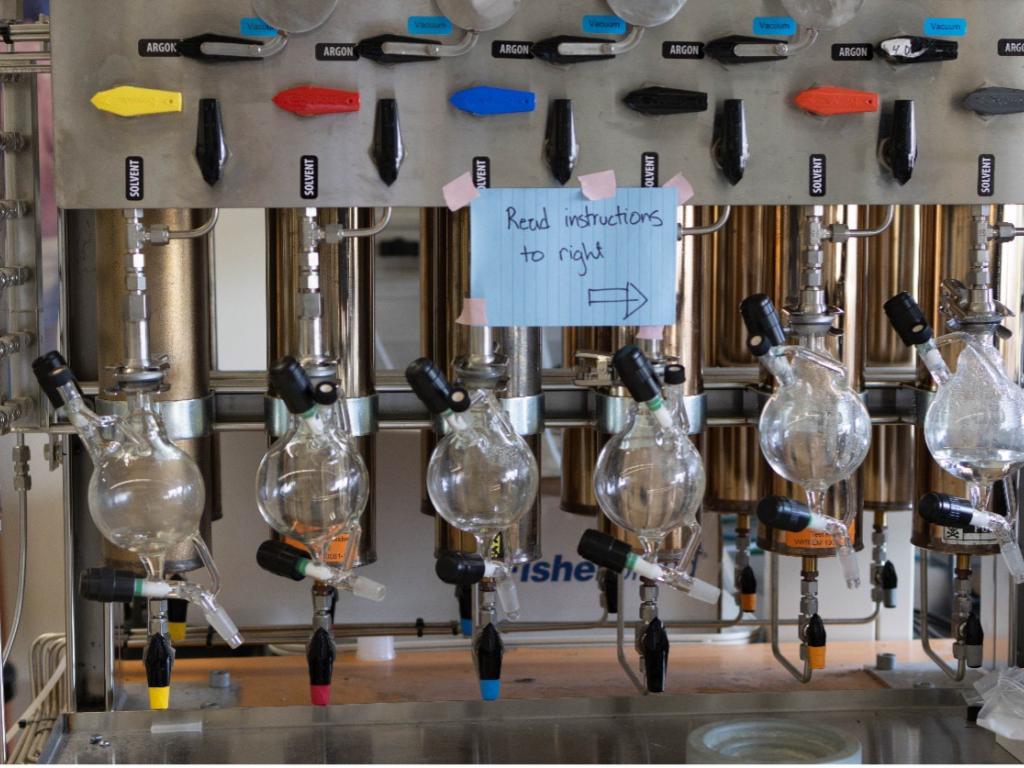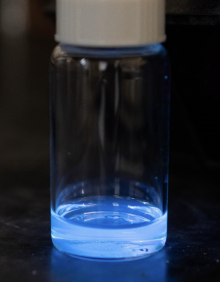
Editor's note: This article was produced by a student participating in the course J477/577: Strategic Science Communication, a collaboration between the School of Journalism and Communication’s Science Communication Minor program and the Research Communications unit in the Office of the Vice President for Research and Innovation.
Ramesh Jasti’s lab spans nearly the entire length of Klamath Hall at the University of Oregon.
“This is where the magic happens," said Jasti, professor of chemistry and biochemistry, as he walks in. The lab has four long tables, each with fume hoods on either side and bottles of reactants and products on shelves. There’s writing on the fume hood covers and tables—reminders of formulas, procedures, and equations, as well as doodles and little drawings.
In this lab, Jasti’s team of graduate students works on synthesizing new carbon nanomaterials that can be used for several applications, such as biological imaging. The group’s original focus was nanotubes.
“We make these little, tiny cylinders, they’re made of little carbon atoms, and they don’t act like regular cylinders,” Jasti said.

They also glow, brighter and longer than most other fluorescent materials.
But instead of using the typical method of generating carbon nanotubes by burning carbon, which tends to create tubes of different lengths and diameters, the lab team uses organic chemistry. This way, they can control exactly how the material is structured down to the individual atom.
Jasti describes it as “molecular architecture.” Instead of looking at a city and trying to pick out the types of buildings that you want to look at, they’re building their own buildings brick by brick.
Just as changes in the building material and structure alter how a building looks and what one can use it for, changing the elements that make up the nanotubes and the size of the nanotubes changes their properties.
They started out by making carbon nanohoops, which are one layer of a nanotube, like the foundation of a building. Jasti said, “What I’m hoping is one day you take this and somehow you get a reaction to occur that puts a bunch of them together and you get one singular, pristine carbon nanotube.”
They’ve been able to connect three hoops together in a pinwheel-like formation, which they can then crystallize to form a solid. They can also make two rings that interlock with one another. The rings can move independently and exchange energy but can’t be separated.
Looking toward future implementation
While these new materials have many potential uses, one of the most promising is biological imaging. Because the nanohoops glow, they can be attached to a part of a biological process and follow it. The hoops are more stable than the other fluorescent materials typically used for imaging, and so they can be used for more things. Currently, a lab in the Phil and Penny Knight Campus for Accelerating Scientific Impact is 3D-printing materials with fluorescent dyes made of nanohoops on which cells can grow—a process that is possible because these hoops can withstand heat up to 300 degrees Fahrenheit. Jasti foresees applications in dental and surgical materials, but they’re still a ways off from these materials being commercially applicable.
"What we’re doing now is learning what are the fundamental properties of these materials and how they could be used,” Jasti said. “If you look at a lot of things that come to have an applied, actual use outside of a lab, often it’s not the way the person that invented it thought it would be used. That’s why it’s important to do fundamental research, because sometimes you can’t guess what an invention will actually be used for.”
Jasti first helped develop this method of making carbon nanomaterials when he was a postdoc at the University of California at Berkeley, and now there are groups all over the world using organic chemistry in nanotechnology. “What others are going to look for and how they might design them often are things that we never thought of,” Jasti said. “Just being able to develop the methods that allow you to investigate the materials probably has the bigger impact than exactly what specific application we’re looking at.”
Jasti’s lab often collaborates with others working on similar research. It’s not about what one lab or one scientist can do on their own, but what they can do together. Jasti believes this is only the beginning.
“A chemist from somewhere else can look at how we did this, and they can design a new type of structure that we haven’t made that they might want to study,” he said. “Having developed the way to do it opens up the possibilities. That’s become even more exciting to me than trying to create the nanotubes. What other structures can we dream up that we can make?”
